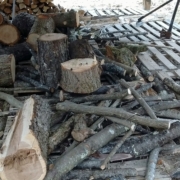Hedgerow Wood
Hedgerow Wood
I’ve seen a number of “silver lining” commentaries recently. This is not one of them: there isn’t such a thing in the midst of a pandemic that has killed tens of thousands and put tens of millions out of work. This is simply a reminder that, if you’re forced to stay at home, you can be grateful if your home is in rural Vermont. Even in April. Even in an April where it won’t seem to stop snowing. I can’t count the number of times, as we’ve walked our fields and woods recently, that my wife and I have commented on how fortunate we are to not be stuck inside a city high-rise apartment. The time at home has also removed excuses for putting off jobs around our farm. We have an eight-acre field that has been steadily shrinking as the hedgerow around it creeps in. So for the last month, we’ve been cutting it back. And, as a bonus, keeping our outdoor woodstove in business even as our season’s supply of “real” firewood has run out. Hedgerow firewood is an unpredictable amalgamation of sizes and species. We’ve cut 12-inch-diameter cherry and 2-inch beech; white birch and white pine; spruce and striped maple. There are not a ton of BTUs involved, but plenty enough to heat our house and hot water in spring temperatures. More importantly, we’re keeping our field from being choked down and keeping ourselves outdoors.

